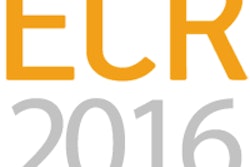
VIENNA - A multicenter study of 500 patients using dynamic contrast-enhanced ultrasound (DCE-US) nudges radiologists further toward standardization in functional evaluation of tumor perfusion, which until recently was lacking in the toolkit of oncologic imaging specialists, ECR attendees learned on Friday.
The study, outlined by speaker Dr. Nathalie Lassau, head of the laboratory of multimodality imaging at the renowned Institut Gustave-Roussy in Villejuif, France, was a vital component in a presentation in which DCE-US was compared with CT, MRI, and PET at a joint session of the European Society of Radiology (ESR) and the European Federation of Societies for Ultrasound in Medicine and Biology (EFSUMB).
 Dr. Nathalie Lassau from Villejuif, France.
Dr. Nathalie Lassau from Villejuif, France.
Previously, there was little or no consensus about the parameters or the timing for early evaluation of antiangiogenic drugs. But the French research has demonstrated the feasibility of DCE-US and now helped provide an update to good clinical practice recommendations on the best parameters and timing for evaluating response to antiangiogenic therapies using contrast-enhanced US.
The study found that using raw linear data pertaining to blood volume after bolus injection, a decrease of 40% at one month post-treatment in the area under the curve (AUC) correlated significantly to progression-free survival and overall survival. This was welcome news to radiologists seeking standardization in therapy validation strategies.
"The good news is that all companies routinely provide this raw linear data for performing quantification," she said.
In the panel discussion, delegates were keen to find out how soon tumor response could be evaluated by ultrasound, and queried the choice of one month as the imaging follow-up point.
"Early changes in tumor perfusion can be seen in the days or weeks after treatment with ultrasound, and with a vascular disrupting agent, even hours afterward as demonstrated on MRI. But when we discussed this with the oncologists, they said it was not very useful to have this information, because they want to compare the toxicity of the drug, how the patient seems to be and imaging," Lassau noted.
She went on to explain that for oncologists, knowing very early response might be interesting, but colleagues at her hospital were not willing to propose a change in drug for a patient before one month post-treatment had elapsed.
Clearing up any areas of uncertainty over the usefulness of volume ultrasound imaging in the clinical setting, Dr. Michel Claudon, a professor of radiology and the head of imaging at University Hospital of Nancy, France, compared 3D ultrasound to a real-life adult-sized garden tool, and also to a child's beach spade, asking the question: Tool or toy? Decisively on the side of the former, he pointed out that advances in probe technology had led to shorter acquisition times and improved resolution. A series of rapid rhetorical questions followed, answered just as quickly by the expert.
Why do radiologists like CT and MRI? Clearly because of the advantages involved, namely speed of data capture and permanent storage with capacity for peer review or second reading, as well as high resolution, flexible manipulation, and analysis features such as measurements, multiplanar reformatting (MPR), maximum intensity projection (MIP), and surface rendering. Patients, on the other hand, aren't so keen on the intrusion of these modalities, he explained. He also asked whether or not the same rapid acquisition of volume data with the same high resolution in 3D and with the same flexible manipulation and analysis features could be obtained with the more patient-friendly ultrasound.
Slow acquisition, a relatively limited field-of-view, poor z resolution, and respiration and movement artifacts were among the impediments to volume imaging when using mechanical probes that were first seen on the market at the beginning of this century. Electronic probes that appeared in 2004 have largely overcome the problems of mechanical probes.
"You are able to decrease the slice thickness because you are able to focus the third dimension in the elevation plane," said Claudon, detailing the other advantages of the electronic probe: The focused beam can be placed anywhere within the field of the transducer, meaning there is better spatial resolution and image uniformity that can be maintained at depth, as well as improved B and C plane resolution in volume ultrasound MPR. Furthermore, live multiplane imaging and volume acquisitions taking typically less than a second provided a safe and real-time approach to diagnostic imaging.
While using 3D and 4D ultrasound in the past hampered workflow, today's advances in PACS and remote reading and reporting mean that volume imaging could be smoothly integrated in the clinical setting. In the future, integration of volume imaging and fusion would yield high-quality dynamic imaging of organs and lesions, he remarked.
"The first ultrasound session showed 'Good results through cooperation', this second through 'combination,' " said moderator Dr. Lorenzo Derchi, from Genoa, Italy. "From different points of view we are working toward a single one which is patient-focused."
Originally published in ECR Today on 8 March 2014.
Copyright © 2014 European Society of Radiology



















